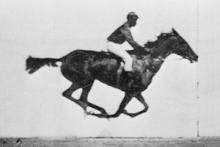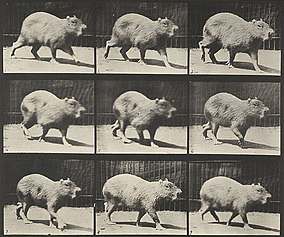What Did Muybridge Use To Study Animal Locomotion


Muybridge, horse galloping, 1887

Muybridge race horse animated (1887)
Creature Locomotion: An Electro-photographic Investigation of Consecutive Phases of Creature Movements (1872–1885) is a series of scientific photographs by Eadweard Muybridge to study motion in animals including humans.[1] In all, over 100,000 images were made, resulting in a portfolio of 781 composite collotype prints published in 1887.[two]
Following his invention of the zoöpraxiscope and motion studies in California, Muybridge was deputed by the University of Pennsylvania to oversee the photographic aspects of a scientific study of animal motility. Work from the commission was subsequently published every bit an 11-book portfolio set titled Animal Locomotion. The trunk of piece of work is celebrated for its contribution to both the art of photography and to science.[3]
History [edit]
In 1879, Muybridge created the zoöpraxiscope (animal action viewer), a project device that created cyclical animations of animal move, incorporating technologies from photography, the magic lantern and the zoetrope. The photographer created painted sequences on the glass zoöpraxiscope discs that were based on his movement-study photographs to produce an early on form of blitheness. Muybridge used these to illustrate his lectures that were presented to audiences in the U.Due south. and Europe, marking his contribution to photography and film in relation to the "feel of time within modernity."[4] [five]

Zoopraxiscope disc by Muybridge, Horse Galloping
In a 1885 news written report, the photographer stated that his interest in animal movement was inspired by observing an hawkeye flight in the Yosemite Valley in California some years prior. Muybridge described the bird as making "numerous flaps with its wings, but in flying across a valley to another peak information technology went for a distance of over a mile with but ane flap of the wings. I was convinced that individual feather movements upheld and propelled the bird, and I tin can bear witness by the negative plates of the hawkeye whose flight we photographed last Th that my determination was correct." These earlier photographs in California formed the basis for his later work with the University of Pennsylvania.[6]
While working in California, Muybridge used the wet-plate collodion procedure in making his albumen-impress photographs. Once he got to Philadelphia, he began to employ a standardized dry-plate process, involving quicker exposure times; these were printed using the collotype photomechanical procedure.[half dozen]
Muybridge committee [edit]

Eadweard Muybridge, Ostrich Running, animation
The Animal Locomotion project was a collaborative endeavor between the lensman and the institutional commissioning commission at the University of Pennsylvania.[6] In 1883, Muybridge met with William Pepper and J.B. Lippincott to talk over a programme for a scientific written report focused on the assay of creature and human being motion. The university contributed $5,000 to what would be a total cost of about $30,000, seeing the proposed project every bit important research that would benefit anthropology, physiology, medicine and sports.[5] Using a 12-camera photographic rig, Muybridge made series of sequential images that captured humans walking downwards stairs, pole vaulting, running, wrestling and other activities. Muybridge'due south chronophotographic studies included animals likewise, and even exotic species borrowed from the Philadelphia Zoo.[7] These plates included The Horse in Motion, Capybara Walking depicting the globe's largest rodent,[8] [9] Ostrich Running [10] (besides printed as a cyanotype)[11] and American Bison Cantering,[12] among other representations of animals.[2] Some of these studies were conducted using a 24-camera photographic rig. The cameras were placed 27-inches apart aslope a track containing trip wires that triggered the shutters on the cameras.[13]
Between the years of 1883 and 1886, Muybridge was engaged in a productive menses at the University of Pennsylvania when he and his team produced over 100,000 images of locomotion in humans and animals.[ii] The painter Thomas Eakins worked with him briefly, although the painter preferred working with multiple exposures on a single negative, whereas Muybridge preferred capturing movement through the use of multiple cameras.[xiv]
Content and publication [edit]
Muybridge would publish his report every bit an xi volume set, consisting of 781 plates, each presenting the successive photographic images of a single field of study, under the title Animate being Locomotion. Alternatively, individual subscribers had the option of selecting 100 plates of their choosing from the portfolio's prospectus and complete catalog for $100.[2] Contrary to the animal focus suggested past the title of the collection, only about 200 of the images represented subjects other than humans, and many of the brute plates featured horses, the latter partially a effect of Muybridge's offering private owners to photograph their horses in substitution for a contribution to the cost of the study.[v] In many cases the homo images featured nude or partially-nude men or women, directly confronting a local controversy over the use of nude models in art.[5] Though the animals were typically photographed running or walking across the frame, human subjects were besides portrayed performing activities ranging from typical daily tasks to competitive athletics.[2]
Reception [edit]
Muybridge's Animal Locomotion project received attention in the news, who reported on his unusual character and eccentricities as well equally the photographic project.[6] The collection's portrayal of nude subjects has been the focus of a directed scholarly study.[15] [16]
Affect on other artists [edit]
Historians and theoreticians have proposed that Muybridge'south work on animal locomotion influenced a number of other artists, photographers and filmmakers, including Marcel Duchamp, Thomas Eakins, Walt Disney, amid others.[17] [18] [nineteen] [20] The composer, Philip Glass created a three-part chamber opera titled The Photographer in 1982 that featured a slide show of the motion studies in the 2nd act.[21] The conceptual creative person, Sol LeWitt was inspired past the series nature of the Animate being Locomotion studies, and produced works that directly refers to it.[22] [23] [24]
In 1992, the Addison Gallery of American Art produced the exhibition, Motion and Document–Sequence and Fourth dimension: Eadweard Muybridge and Gimmicky American Photography, pairing Muybridge's animal move studies with the work of 42 artists and photographers amongst them Vito Acconci and Sarah Charlesworth. The show later traveled to the Long Beach Museum of Art.[24]
Collections [edit]
The University of Pennsylvania houses the Muybridge Collection, which contains 740 of the 781 plates, along with some of his photographic equipment.[2] Images from the series are held in numerous permanent collections including the Purple Academy of Arts,[10] Pennsylvania Academy of Fine Arts,[25] the Metropolitan Museum,[26] the Brooklyn Museum,[27] the Museum of Mod Art[28] and others.
Gallery [edit]
-

Muybridge, American Buffalo cantering, animated
-

Animal locomotion, Capybara Walking
-

A man walking while bearing load on shoulder.
-

Woman walking downstairs (1887)
References [edit]
- ^ Williams, Talcott (1887). "Animal Locomotion in the Muybridge Photographs". Century Magazine . Retrieved 26 February 2022.
- ^ a b c d e f "A new way of thinking virtually movement, motility, and the concept of time". Penn Today. Academy of Pennsylvania. Retrieved 26 February 2022.
- ^ "Eadweard Muybridge: Creature Locomotion". Huxley-Parlor Gallery. 2017. Retrieved 27 Feb 2022.
- ^ "Eadweard Muybridge: Defining Modernities". Arts and Humanities Enquiry Council, Kingston University, London. Retrieved 26 February 2022.
- ^ a b c d "Motility Pictures: The Zoopraxiscope". Tate Museum. Retrieved 26 Feb 2022.
- ^ a b c d Gordon, Sara Anne (2015). Indecent Exposures: Eadweard Muybridge's Animal Locomotion Nudes. Yale Academy Press. ISBN9780300209488 . Retrieved 26 February 2022.
- ^ Neda Ulaby (thirteen April 2010). "Muybridge: The Man Who Made Pictures Move". NPR.
- ^ "Eadweard Muybridge, Capybara Walking". Retrieved 26 February 2022.
- ^ Muybridge, Eadweard. "Capybara; walking". George Eastman Museum. Retrieved 26 February 2022.
- ^ a b "Ostrich; Running Ostrich; running, 1872-1885". Royal Academy of Art. Retrieved 1 March 2022.
- ^ "Ostrich, running". Smithsonian Institution: National Museum of American History. Retrieved 1 March 2022.
- ^ Phippen, J. Weston (24 July 2016). "The Man Who Captured Time". The Atlantic . Retrieved 26 February 2022.
- ^ Martinique, Elena. "Mastering Movement - The Revolution of Photographer Eadweard Muybridge". Widewalls. Retrieved 26 Feb 2022.
- ^ Brookman, Philip; Braun, Marta; Keller, Corey; Solnit, Rebecca (2010). Helios: Eadweard Muybridge in a Time of Alter. Germany: Steidl. p. 83. ISBN978-three-86521-926-8 . Retrieved 27 February 2022.
- ^ Sarah Gordon (2015). Indecent Exposures: Eadweard Muybridge'due south "Beast Locomotion" Nudes. new Haven: Yale University Press.
- ^ Hashemite kingdom of jordan Bear (2016). "REVIEWS: Subjects Framed and Illuminated - Indecent Exposures: Eadweard Muybridge'due south "Animal Locomotion" Nudes, by Sarah Gordon". The Art Bulletin. 98: 526–528. doi:10.1080/00043079.2016.1215187. S2CID 193728441.
- ^ Campany, David. "Moving with the times: Eadweard Muybridge I". Tate Museum. Retrieved 26 February 2022.
- ^ "Legacy". Muybridge the Moving picture. 4 December 2013. Retrieved 26 February 2022.
- ^ "Infamy and Influence". Cleveland Establish of Fine art. 23 February 2016. Retrieved 26 February 2022.
- ^ "Eadweard Muybridge". Kingston Heritage Service. Retrieved 26 Feb 2022.
- ^ Rockwell, John (7 October 1983). "Philip Drinking glass's "Photographer"". The New York Times . Retrieved 26 February 2022.
- ^ "Sol LeWitt: Schematic Drawings for Muybridge II, 1964". Albright Knox Gallery. Retrieved 26 February 2022.
- ^ Solnit, Rebecca (three September 2010). "Eadweard Muybridge: Anxiety off the footing". The Guardian . Retrieved 26 February 2022.
- ^ a b Knight, Christopher (6 August 1992). "ART REVIEW : Muybridge and 'Motion': A Beguiling History Lesson". Los Angeles Times . Retrieved 26 February 2022.
- ^ "Animal Locomotion, Book IX, Horses. Plate 597, Eadweard Muybridge". Pennsylvania Academy of Fine Arts. 14 February 2017. Retrieved 26 February 2022.
- ^ "Animal Locomotion. An Electro-Photographic Investigation of Consecutive Phases of Animal Movements. Commenced 1872 - Completed 1885. Book Nine, Horses". Metropolitan Museum. Retrieved 26 February 2022.
- ^ "Animal Locomotion Eadweard Muybridge". Brooklyn Museum. Retrieved 26 February 2022.
- ^ "Eadweard J. Muybridge, Woman Dancing (Fancy): Plate 187 from Brute Locomotion (1887) 1884-86". Museum of Mod Art. Retrieved 26 February 2022.
Further reading [edit]
- Hendricks, G. Eadweard Muybridge: The Begetter of the Movement Picture (London: Secker and Warburg, 1975)
- Muybridge, Eadweard. Muybridge'due south Consummate Human and Fauna Locomotion, Vol. I: All 781 Plates from the 1887 "Fauna Locomotion" (1979) Dover Publications ISBN 9780486237923
- Muybridge, Eadweard. Descriptive Zoopraxography, or the Scientific discipline of Creature Locomotion Made Popular (1893) Library of Alexandria. ISBN 9781465542977
- Solnit, Rebecca. Movement Studies: Fourth dimension, Space and Eadweard Muybridge (London: Bloomsbury, 2004)
External links [edit]
- Creature locomotion : an electro-photographic investigation of consecutive phases of animal movements Prospectus and Itemize of Plates
- Eadweard Muybridge Collection, at the University of Pennsylvania
Source: https://en.wikipedia.org/wiki/Animal_Locomotion
Posted by: morganknor1997.blogspot.com

0 Response to "What Did Muybridge Use To Study Animal Locomotion"
Post a Comment